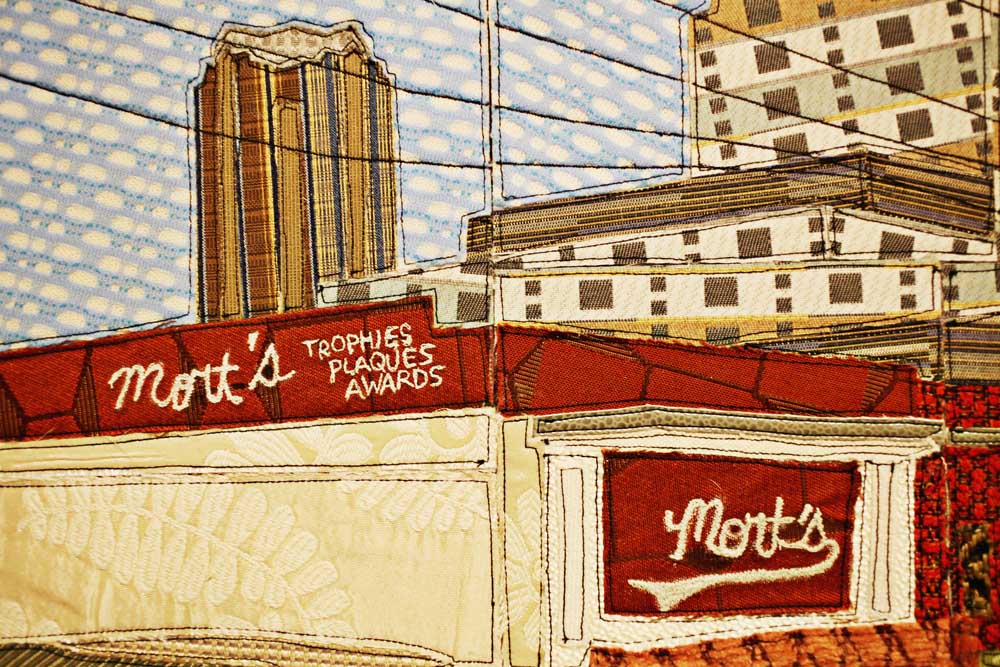Rising visual artist in North Carolina sews the scene
Published 12:00 am Saturday, July 9, 2016

- A detail is shown from Caitlin Cary’s piece “Mort’s Trophy Shop, W. Davie St.” Juli Leonard / The (Raleigh, N.C.) News & Observer via Tribune News Service
RALEIGH, N.C. — Caitlin Cary was leading the way to her studio in downtown Raleigh’s Artspace when something caught her eye. It was a clear plastic bag stuffed full of fabric scraps in a wide range of colors and patterns.
“Ooh,” she said with a laugh, “it’s hard to pass by a big bag o’ cloth.”
Many people would have seen that bag’s contents as rags at best, trash at worst. But cast-off fabric serves as raw material for the 47-year-old Cary’s highly idiosyncratic visual art — Freehand Sewn Collage, or Needle Print for short — fabric portraits depicting various structures that will be familiar to Raleigh denizens.
Cary has been making and selling these for a couple of years now, capturing everything from the Rialto Theatre to an anonymous garage on a downtown street corner. Other works depict iconic local structures including the downtown Holiday Inn, Char-Grill, Finch’s Restaurant, Dorton Arena and Krispy Kreme Doughnuts. In progress is one on a now-closed and soon-to-be-demolished International House of Pancakes.
Initially, buildings emerged as primary subject matter due to the simple matter of practicality — they have more straight lines than curved ones and are therefore easier to render. But over time, Cary has delved further into conceptuality and even politics. Last year, she did a piece for a Planned Parenthood auction depicting the North Carolina State Legislative building in shades of pink.
“I am fascinated by buildings, how and why certain iconic buildings matter and the ones that do or don’t get noticed,” Cary said. “We use buildings to sentimentalize their place. I feel like this is the ‘document everything about Raleigh, quick, before it gets torn down’ project.”
A modicum of research is involved, but that part of the process is more casual interest than slavish obsession. Cary is less interested in a given building’s history than capturing its overall visual vibe in a way that a newcomer could relate to without necessarily knowing the background.
“My bent is I’m comfortable not knowing a lot about the buildings,” she said. “So I can let them inspire me in a more imaginative, poetic kind of way. Like that Holiday Inn. I always thought it looked like a hair curler. So that’s what I called it, ‘Hair Curler Holiday Inn.’”
While she’s always had a crafty streak, visual art is a relatively recent field for Cary — an acclaimed musician who first gained notice in the mid-1990s as a fiddler/singer alongside Ryan Adams in Whiskeytown. Since then, she’s played in Tres Chicas and Small Ponds, made a handful of acclaimed solo albums, had a song covered by Joan Baez (“Rosemary Moore,” on the folk legend’s 2003 album “Dark Chords on a Big Guitar”) and served as co-leader of the NC Music Love Army activist collective.
For most of Cary’s adult life, however, music and art have had to take a back seat to the practical business of making a living on Planet Dayjob.
“After I graduated from college, I had exactly two job interviews and that ended all my attempts at finding a ‘real’ job,” she said. “They were both so demoralizing. But it was obvious I would’ve been unhappy with either one, so it’s just as well. From then on, it was mostly working in bars and restaurants.”
When she was tending bar at the Pour House nightspot in downtown Raleigh a few years back, Cary helped organize Insplosure, an artists’ craft market coinciding with Artsplosure in Moore Square. That got Cary sewing things herself, including baby clothes and greeting cards with fabric designs of “bunnies, veggies, barns, whatever” sewn onto cardboard.
Eventually that led to larger and more detailed urban landscapes, using photographs cut into panels sized to fit into her sewing machine. With the colors, textures, asymmetrical framing and unusual subject matter, there’s a whimsical, almost outsider-art feel to them. Prices range from a few hundred to a few thousand dollars, depending on size and complexity.
“How long it takes depends on my level of motivation,” Cary said. “The big ones, if you don’t count all the time thinking and scouting, represent about two weeks of day-job hours. I can manage maybe two or three of those a month.”
The pieces are also full of details with stories attached to them. The Rialto piece, for example, is one of Cary’s rare works that also features a human figure. The person shown buying tickets at the box office is her husband, Skillet Gilmore — in denim made from a piece of the real-life Gilmore’s actual blue jeans.
“So far it’s pretty low-tech,” Cary said. “I blow up photos to scale, draw all over them, cut them up and then the photo itself becomes the pattern. The function is that each one has to fit in the space in the sewing machine. The generally asymmetrical thing is an important feature of the work. I think they’d be significantly less interesting without that.”






